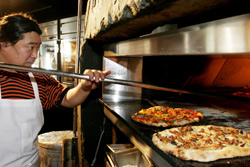Not since Wolfgang Puck introduced his cracker crust at Spago’s in the 1980s has the West Coast seen such interest in upscaling its pizza. Over the past two years, the San Francisco Bay Area has exploded with restaurants specializing in pies with exquisite crusts, recherché toppings, and prices to match. Here in Seattle, the revolution has been an “authentic Neapolitan” one, complete with certifications and imported silverware for cutting up unsliced pies. Now Tom Douglas joins in with Serious Pie.
It was originally a matter of efficiency. When Douglas and his head bread baker, Gwen Grande, were plotting an overhaul of the Douglas restaurants’ bread facilities, they asked themselves: Why not make pizza dough at the same time? The whim soon snowballed into an impec-cably thought-out restaurant. Douglas designed the space and had Bellingham-based Wood Stone install a wood-fired oven, and Grande spent weeks crafting her ideal pizza dough.
What she came up with bodes well for the future of Seattle’s heretofore doughy cheese bombs. I had some good slices and some amazing ones at Serious Pie, with great service, wines, and appetizers to boot. But I also worry that Douglas is pushing the high-end-pizza-experience too far.
A menu the size of a mani-pedi flyer lists a half-dozen pies, with another daily special recited by the waiter. In Douglas style, many of the ingredients are seasonal and organic, and the sausages, mozzarella, and salumi made in-house. While the toppings are typical of these new upscale pizzas, Grande’s crusts are like no other. Pulled into foot-long ovals, the pies are baked in the 700-degree oven until they form an impeccable, crackly shell, leaving the ciabattalike interior airy and tender.
When the crust comes correct, it’s beautiful, with a hint of smoke from the oven. However, when the pizza is topped with a sauce rather than brushed with olive oil, the cooks tend to leave the pizza in longer, and the bottom scorches and becomes bitter. To that effect, stay away from the mozzarella-tomato-basil model, as well as the one with sauce, sautéed peppers, sausage, and enough oregano to perfume a bushel of tomatoes.
A more welcome aroma: the pizza with sautéed mushrooms and truffle cheese, smelling of sex by the fire. Or the fresh rosemary scenting the potato pizza, the most delicious of the lot: I expected starch-on-starch blandness, but the crust is tiled with slices of earthy red-skinned potato, then showered with salty Parmigiano-Reggiano.
Another favorite was the white anchovy pizza, covered in a fresh, chunky tomato relish, dotted with black olives, and crisscrossed with Spanish pickled anchovies, their vinegary impact succeeded by a long chile burn. And one nightly special rocked all our worlds: diced prosciutto, salty and a little crunchy, combined with julienned peppers, roasted shallots, and provolone and Parmesan cheeses. It contained almost too much flavor. Almost.
Everything that came before and after the pizza was simple and expressive. Roasted baby beets were paired with their own greens, their sweetness and bitter, almost cinnamonlike richness alloyed with a splash of cherry vinegar. Radishes as crisp as new-crop apples were hidden between the lightly dressed leaves of a Jericho lettuce salad. One nightly special of roasted chanterelles, which came with toasts brushed with lemon oil for scooping, had been tossed with shallots and cider vinegar—just enough that a few bright drops would appear here and there to cut through the woodsiness of the mushrooms like a break in the trees. And the zucca al forno, slices of a sweet winter squash roasted in the oven until creamy, were napped with a bagna cauda dressing of garlic, anchovies, and capers, the perfect foil to their sugar.
Desserts, too, were spare but potent.The shells on the mini cannelloni were a little indelicate, but I loved swiping bites of the crust and smooth, thick ricotta filling across the plate, gathering crumbled pistachios in apple and burnt-orange syrup. And a cranberry “hand pie” was more of a cranberry shortcake, the cakey pastry matched with an intense cranberry-orange compote.
Douglas has not lost his gift for ambiance. You reach the tiny place around the corner from the Dahlia Lounge, descending a half-flight of stairs into a masculine, intimate room—hunting lodge meets pub. Campfire light glows from wrought-iron chandeliers. The communal tables are long and chest-height (yes, you’ll probably be seated next to strangers), the seats comfortable low-backed stools. Through a wall of windows opposite the street side, you can peer into the industrial ovens or watch Douglas’ bread elves palpate dough.
It all bespeaks a casual meal, refined but not overly so. Yet dinner—say, one pizza, a glass of wine, a shared appetizer, and a dessert half—averages $35 (about $10 above similar pizza meals in San Francisco and $5–$10 above others in Seattle). I’m all for anyone in the restaurant business being able to turn a profit, but when they do it by charging special-event prices for casual food, my hackles rise. Oh, I’ll be back for Douglas’s seriously delicious pies. Just not as soon, or as often, as I’d like.






